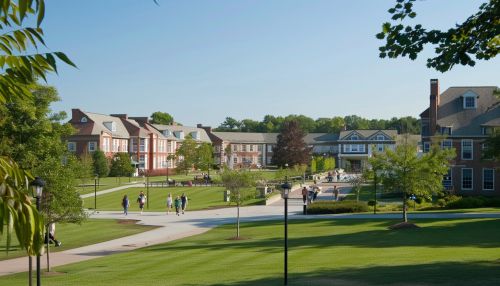Liberal arts colleges in the United States
Overview
Liberal arts colleges in the United States are a specific type of higher education institution that emphasize broad, interdisciplinary learning, as opposed to more specialized technical or vocational training. These colleges are known for their small class sizes, close-knit communities, and focus on undergraduate education. They offer a wide range of majors and minors in the humanities, social sciences, natural sciences, and arts, allowing students to explore a variety of academic disciplines.
History
The concept of a liberal arts education dates back to the Ancient Greeks, who believed in educating the whole person, including the mind, body, and spirit. This philosophy was later adopted by the Romans and incorporated into the medieval education system. The first liberal arts colleges in the United States were established in the 18th century, modeled after the European universities of the time. These early colleges included institutions such as Harvard, Yale, and Princeton, which were originally founded as liberal arts colleges before eventually expanding into comprehensive research universities.


Curriculum
The curriculum at a liberal arts college is designed to provide students with a broad base of knowledge and skills. Students are typically required to take a variety of general education courses in areas such as English, history, mathematics, science, and the arts. These courses are designed to expose students to a wide range of academic disciplines and to develop critical thinking, problem-solving, and communication skills.
In addition to their general education requirements, students at liberal arts colleges choose a major area of study. This major provides more in-depth study in a particular academic discipline. Some of the most popular majors at liberal arts colleges include English, history, psychology, biology, and political science. Many liberal arts colleges also offer interdisciplinary majors, which allow students to combine interests in multiple academic disciplines.
Benefits of a Liberal Arts Education
There are several benefits associated with a liberal arts education. First, the broad-based curriculum exposes students to a wide range of academic disciplines, encouraging intellectual curiosity and lifelong learning. This exposure can also help students discover new interests and passions, which can influence their career paths.
Second, the small class sizes and close-knit communities at liberal arts colleges can foster strong relationships between students and faculty. This can enhance the learning experience and provide students with valuable mentorship opportunities.
Finally, the skills developed through a liberal arts education, such as critical thinking, problem-solving, and communication, are highly valued by employers in a variety of industries. As a result, graduates of liberal arts colleges often have strong job prospects and career advancement opportunities.
Challenges and Criticisms
Despite the many benefits of a liberal arts education, these colleges also face several challenges and criticisms. One common criticism is that a liberal arts education is not practical or relevant to the job market. Some argue that the broad-based curriculum does not provide students with the specialized skills needed for certain careers.
Another challenge for liberal arts colleges is the cost. These institutions often have high tuition rates, and the financial burden can be a significant barrier for many students. However, many liberal arts colleges offer generous financial aid packages to help offset these costs.
Notable Liberal Arts Colleges
There are hundreds of liberal arts colleges in the United States, many of which are highly ranked and respected. Some of the most notable include Amherst, Williams, Swarthmore, and Pomona. These colleges are known for their rigorous academic programs, dedicated faculty, and successful alumni.
